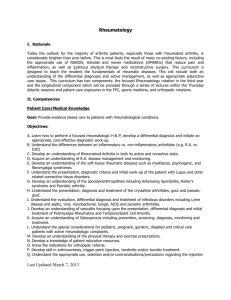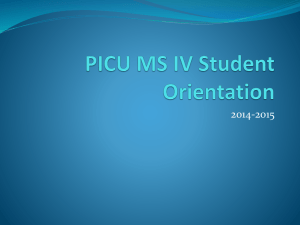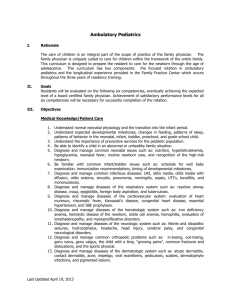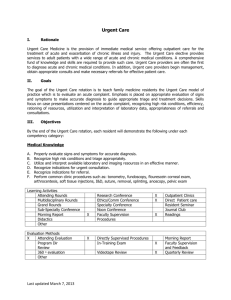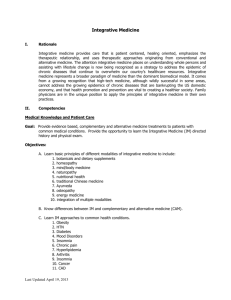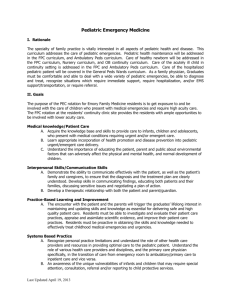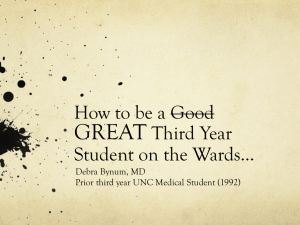Cardiology - Emory University
advertisement
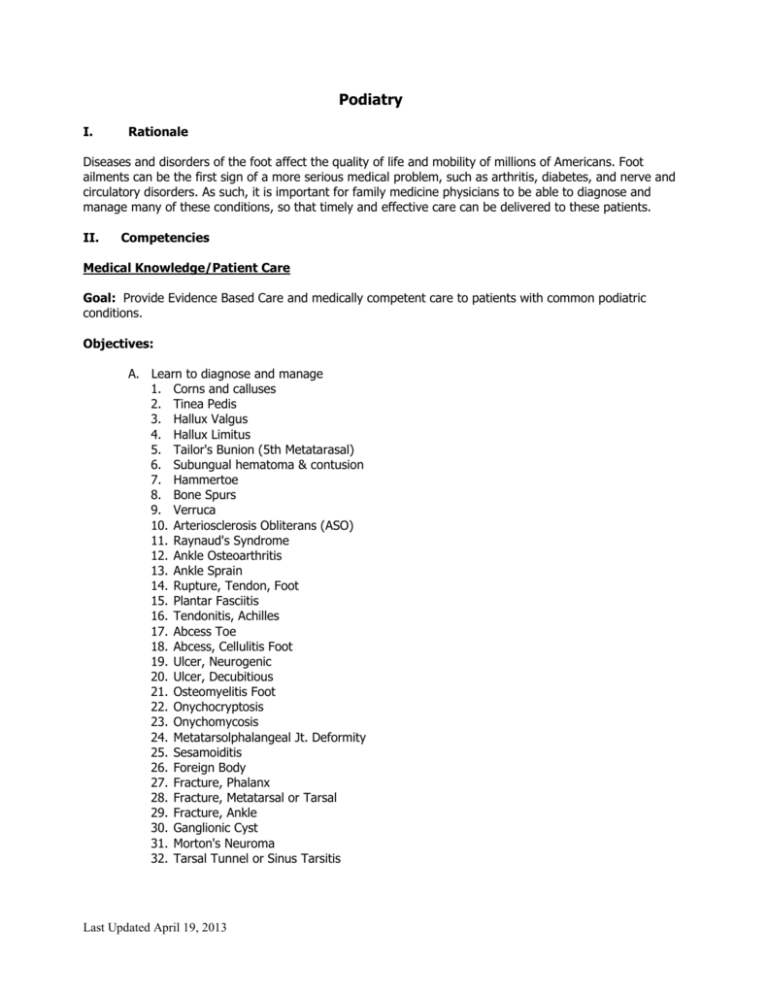
Podiatry I. Rationale Diseases and disorders of the foot affect the quality of life and mobility of millions of Americans. Foot ailments can be the first sign of a more serious medical problem, such as arthritis, diabetes, and nerve and circulatory disorders. As such, it is important for family medicine physicians to be able to diagnose and manage many of these conditions, so that timely and effective care can be delivered to these patients. II. Competencies Medical Knowledge/Patient Care Goal: Provide Evidence Based Care and medically competent care to patients with common podiatric conditions. Objectives: A. Learn to diagnose and manage 1. Corns and calluses 2. Tinea Pedis 3. Hallux Valgus 4. Hallux Limitus 5. Tailor's Bunion (5th Metatarasal) 6. Subungual hematoma & contusion 7. Hammertoe 8. Bone Spurs 9. Verruca 10. Arteriosclerosis Obliterans (ASO) 11. Raynaud's Syndrome 12. Ankle Osteoarthritis 13. Ankle Sprain 14. Rupture, Tendon, Foot 15. Plantar Fasciitis 16. Tendonitis, Achilles 17. Abcess Toe 18. Abcess, Cellulitis Foot 19. Ulcer, Neurogenic 20. Ulcer, Decubitious 21. Osteomyelitis Foot 22. Onychocryptosis 23. Onychomycosis 24. Metatarsolphalangeal Jt. Deformity 25. Sesamoiditis 26. Foreign Body 27. Fracture, Phalanx 28. Fracture, Metatarsal or Tarsal 29. Fracture, Ankle 30. Ganglionic Cyst 31. Morton's Neuroma 32. Tarsal Tunnel or Sinus Tarsitis Last Updated April 19, 2013 B. Learn a few basic podiatric procedural skills essential to the practice of family medicine. 1. 2. 3. 4. Callus/corn removal Toe nail removal Digital nerve block Cryotherapy Learning Activities Attending Rounds Multidisciplinary Rounds Grand Rounds Sub-Specialty Conference Morning Report Didactics Other Evaluation Methods X Attending Evaluation X Program Dir Review X 360 ᵒ evaluation Other X X X X Research Conference Ethics/Comm Conference Specialty Conference Noon Conference Faculty Supervision Procedures X X Directly Supervised Procedures In-Training Exam X X Videotape Review X X Outpatient Clinics Direct Patient care Resident Seminar Journal Club Readings Morning Report Faculty Supervision and Feedback Quarterly Review Practice Based Learning and Improvement Goal: The resident should develop skills in evaluating their own patient care, appraising and assimilation of scientific evidence to improve patient care. Objectives: A. B. C. D. E. Identify resources for personal education. Develops a plan for ongoing education. Identify Point of Care learning resources. Utilize Electronic Medical Records Decision aid tools and templates for patient care. Recognizes strengths and weaknesses of knowledge and skills in self and others. Learning Activities Attending Rounds Multidisciplinary Rounds Grand Rounds Sub-Specialty Conference Morning Report Didactics Other Evaluation Methods X Attending Evaluation X Program Dir Last Updated April 19, 2013 X X Research Conference Ethics/Comm Conference Specialty Conference Noon Conference Faculty Supervision Procedures Directly Supervised Procedures In-Training Exam X X X Outpatient Clinics Direct Patient care Resident Seminar Journal Club Readings X Morning Report Faculty Supervision X Review 360 ᵒ evaluation Other and Feedback Quarterly Review Videotape Review Interpersonal and Communication Skills Goal: Residents will develop and demonstrate effective information exchange and teaming with patients, their families and other health professionals. Objectives: A. Develop patient sensitive skills for interviewing that allow accurate, and complete collection of information regarding symptoms, the family and the community that affect the patient's health and care. B. Develop skills in communicating results to patients, their families, other health care providers. C. Develop skills in educating patients and their families, in dealing with sensitive issues for patients and families, and in negotiating a plan of investigation and treatment with the patient and family. D. Develop professional relationships with co-workers, consultants, ancillary staff and other professionals to enable assembling of health care teams and mobilization of community resources to optimize care of the patient. E. Develop an understanding of the role of the family medicine consultant, and is able to support the patient through the process of consultation, medical evaluation, treatment, rehabilitation and long-term care. F. Use professional language and demeanor when communicating with other residents, with Family Medicine attending physicians, with physicians from other services, with non-physician clinical staff, with non-physician non-clinical staff, and with patients and their families. G. Create and sustain a therapeutic and ethically sound relationship with patients. H. Use effective listening skills and elicit and provide information using effective nonverbal, explanatory, questioning, and writing skills. I. Work effectively with others as a member or leader of a health care team or other professional group. Learning Activities Attending Rounds Multidisciplinary Rounds Grand Rounds Sub-Specialty Conference Morning Report Didactics Other Evaluation Methods X Attending Evaluation X Program Dir Review X 360 ᵒ evaluation Other Last Updated April 19, 2013 Research Conference Ethics/Comm Conference Specialty Conference Noon Conference Faculty Supervision Procedures X X Outpatient Clinics Direct Patient care Resident Seminar Journal Club Readings X Directly Supervised Procedures In-Training Exam X X X Videotape Review X Morning Report Faculty Supervision and Feedback Quarterly Review X Professionalism Goal: Residents will demonstrate a commitment to carrying out professional responsibilities, adherence to ethical principles, and sensitivity to a diverse patient population. Objectives: A. Demonstrate integrity, honesty, respect and a commitment to excellence in all activities B. Demonstrate sensitivity, respect and adapt appropriately to the social and cultural issues of each patient. C. Display initiative and resourcefulness in patient care and in solving problems. D. Be timely in attendance of activities and completion of tasks. Learning Activities Attending Rounds Multidisciplinary Rounds Grand Rounds Sub-Specialty Conference Morning Report Didactics Other: Evaluation Methods X Attending Evaluation X Program Dir Review X 360 ᵒ evaluation Other X X Research Conference Ethics/Comm Conference Specialty Conference Noon Conference Faculty Supervision Procedures X X Outpatient Clinics Direct Patient care Resident Seminar Journal Club Readings Directly Supervised Procedures In-Training Exam X X Videotape Review X Morning Report Faculty Supervision and Feedback Quarterly Review Systems Based Practice Goal: Demonstrate an awareness of and responsiveness to the larger context and system for health care and the ability to effectively call on system resources to provide care that is of optimal value. Objectives: A. Utilize and understand the importance of appropriate referral or consultation with podiatrists. B. Support of the individual and family through consultation, evaluation, treatment, and rehabilitation. C. Understand the psychosocial and economic impact of podiatric conditions on the individual and family and use of the health care system to assist as needed. D. Learns most cost effective ways to manage patients with podiatric conditions. Learning Activities Attending Rounds Multidisciplinary Rounds Grand Rounds Sub-Specialty Conference Morning Report Last Updated April 19, 2013 X Research Conference X Outpatient Clinics Ethics/Comm Conference Specialty Conference Noon Conference Faculty Supervision X Direct Patient care Resident Seminar Journal Club Readings X Didactics Other X Evaluation Methods X Attending Evaluation X Program Dir Review X 360 ᵒ evaluation Other IV. Procedures Directly Supervised Procedures In-Training Exam Videotape Review X Morning Report Faculty Supervision and Feedback Quarterly Review Instructional Strategies (see above) This is a four-week elective and should be attended by the resident for a minimum of 5-6 half days per week. The other 4-5 half days per week will be spent in the resident’s continuity clinic and in didactics. Readings can be obtained from Section VI and should also be solicited from the Clinic Medical Director and team. V. Evaluation Strategies (see above) A. Observation and end of rotation evaluation from the Podiatry faculty. B. Procedure documentation by the resident C. Conference attendance D. In-training exam profiles E. Resident evaluation of rotation and faculty H. Completion of required readings and scoring >90% on open book Monograph quizzes VI. Implementation Methods This medical elective consists of 6 ½ day sessions per week of Podiatry in a clinical setting of the, for a total of 4 weeks. Location: Robert Schwartz, DPM Foot & Ankle Center 1711 Mt. Vernon Road, Suite 2 Dunwoody, GA 30338 Contact: Charlotte: 770-963-5161 office 678-638-7779 fax Family Practice Center: 5 ½ days per week in the Family Medicine Clinic, 4 ½ days in the Podiatry Clinic. Call/Vacation: Call will be with the Family Medicine Service at Emory University Midtown Hospital. Vacation is permitted. Supervision: Residents will be supervised by Dr. Robert Schwartz. Conferences: The resident is expected to attend Thursday morning Family Medicine Didactics Conferences. Last Updated April 19, 2013 VII. Suggested Readings/Resources 1. 2. 3. 4. 5. 6. 7. 8. 9. 10. 11. 12. 13. AFP Monograph: FP Essentials 307: Common Foot Problems JOAN M. BEDINGHAUS, MARK W. NIEDFELDT. Over-the-Counter Foot Remedies. Am Fam Physician. 2001 Sep 1;64(5):791-797. JOONG MO AHN, GEORGES Y. EL-KHOURY. Radiologic Evaluation of Chronic Foot Pain. Am Fam Physician. 2007 Oct 1;76(7):975-983. MICHAEL R. SIMPSON, THOMAS M. HOWARD. Tendinopathies of the Foot and Ankle. Am Fam Physician. 2009 Nov 15;80(10):1107-1114. ROBERT G. FRYKBERG. Diabetic Foot Ulcers: Pathogenesis and Management. Am Fam Physician. 2002 Nov 1;66(9):1655-1663. JOEL J. HEIDELBAUGH, HOBART LEE. Management of the Ingrown Toenail. Am Fam Physician. 2009 Feb 15;79(4):303-308. JEFFREY D. TIEMSTRA. Update on Acute Ankle Sprains. Am Fam Physician. 2012 Jun 15;85(12):1170-1176. Barrett M. Schroeder. American College of Foot and Ankle Surgeons: Diagnosis and Treatment of Heel Pain. Am Fam Physician. 2002 Apr 15;65(8):1686-1688. DENISE B. FREEMAN. Corns and Calluses Resulting from Mechanical Hyperkeratosis. Am Fam Physician. 2002 Jun 1;65(11):2277-2280. ROBERT G. FRYKBERG. Diabetic Foot Ulcers: Pathogenesis and Management. Am Fam Physician. 2002 Nov 1;66(9):1655-1663 TODD C. SOMMER, THOMAS H. LEE. Charcot Foot: The Diagnostic Dilemma. Am Fam Physician. 2001 Nov 1;64(9):1591-1598. ALFRED F. TALLIA, DENNIS A. CARDONE. Diagnostic and Therapeutic Injection of the Ankle and Foot. Am Fam Physician. 2003 Oct 1;68(7):1356-1363. DANIEL B. JUDD, DAVID H. KIM. Foot Fractures Frequently Misdiagnosed as Ankle Sprains. Am Fam Physician. 2002 Sep 1;66(5):785-795. Last Updated April 19, 2013
